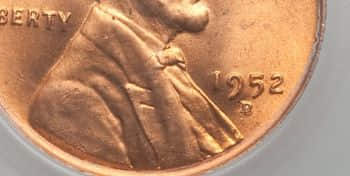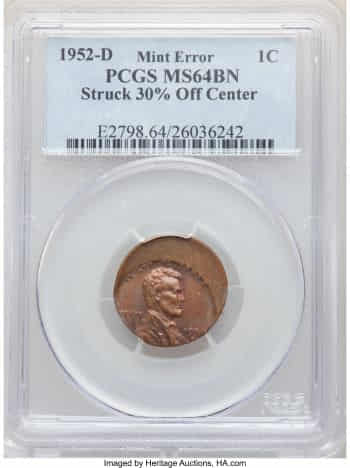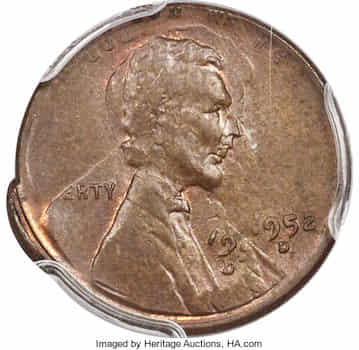Ed. note: This article is periodically updated to reflect the current price of most valuable coins.
In Coleccionistas de Monedas, we fight against the misinformation surrounding the world of coins on the web. For this reason, our articles are written 100% by people (not AI), and we link to all sources and references for coin prices, so you can have real, updated, and reliable information.
Undoubtedly one of the most recognized coins by all collectors and non-collectors in the USA are the pennies (or cents). In this article, we tell you in depth about the value, rarity, and price evolution of the 1952-D Wheat Penny. Although it is the currency with the lowest circulating value in the country, it is very common in our pockets. Its high issuance to meet the demand of the people makes them common but, for this same reason, they are usually found worn out.
The highest price reached in 2023 was for a 1952-D 1C Red with an MS67+ grade, which achieved $3,840 in April.
What are 1952 D Wheat Pennies worth?
Coleccionistasdemonedas.com estimates the value of a 1952-D Wheat penny to be:
|
1952 D Wheat Penny |
MS60 |
MS61 |
MS62 |
MS63 |
MS64 |
MS65 |
MS66 |
MS67 |
|
Price |
$2 |
$2 |
$4 |
$5-6 |
$10-12 |
$20-22 |
$30-90 |
$250-1,450 |
JUMP TO SECTION
The collector values when a penny is in good preservation, a factor for which he is able to pay high amounts, especially for an excellent specimen. Also, certain errors can greatly increase their value, due to their scarcity and high demand by collectors, as we will see later. No exception is the penny in this article, the 1952- D Wheat Penny.
We can see as a reference price this 1952- D Wheat Penny in MS67 quality that got, a few years ago, a price of $867.50 at the prestigious Heritage auction house.
How do we identify a 1952-D Wheat Penny?
Since 1909, U.S. pennies have featured the bust of Lincoln on the obverse, a design by Victor David Brenner.
The weight of these coins remained at 3.11 grams until 1982. The metals that make up a 1952 Wheat Penny are 95% copper and 5% tin and zinc. In contrast, today they weigh as little as 2.5 grams and are made of copper-colored zinc.
On the reverse of the one-cent coins minted between 1909 and 1958, we can see two ears of wheat surrounding, as if it were a laurel wreath, the central legend “ONE CENT – UNITED STATES OF AMERICA”. Just above this legend, appears the Latin motto “E PLURIBUS UNUM” (From many, one), common on American coins.
These spikes are what give the Wheat penny its name.
How to identify the year of coinage
To know the year of the coin we must look at the obverse. There we can see on the right side of Lincoln’s bust “1952”. Under this number there may or may not be a letter, this is the mint, that is, the factory where it was minted. Above the bust of Lincoln, another motto appears, “IN GOD WE TRUST”, and to the left of it, the word “LIBERTY”.
Types of mintmarks of the 1952 Wheat Penny
Although we focus on the Denver mint in this article, it should be noted that there are two other mints, the Philadelphia and San Francisco mints.
To identify the mints on our cents, just look at the letter on the obverse, which has been mentioned above, under the number indicating the year of issue.
The types are:
- no mint mark: it is therefore mint of Philadelphia.
- letter D: corresponds to the mint of Denver.
- letter S: indicates that it was minted at the San Francisco mint.
How many of the 1952 D Wheat pennies are there?
In 1952, more than 1,000,000,000 Wheat Penny were minted in total. The most productive mint was Denver, which produced 746,130,000 units, a large percentage.
It should be noted that of the large number of coins issued in Denver in 1952, not all have survived to the present day, and the number of these cents is much smaller.
It is important to know these mints for our 1952 Wheat Penny, because there is an error related to these letters, as we will see below.
How do I know the grade of my D Wheat Penny from 1952?
The higher the grade, the higher the price increases exponentially, as it is a factor of great importance, especially in coins that tend to circulate a lot, such as pennies.
To know the state of conservation of the coin we own or want to buy, we need to have an expert eye that we can hardly acquire without time or experience. This is why it is not a bad idea to resort to a TPG (Third Party Grading Service). These are companies dedicated to evaluate and grade our coins according to their condition. In addition, they certify the authenticity and encapsulate the coin for security purposes, both for its preservation and to facilitate its sale.
What are the rarest 1952-D Wheat Penny specimens and their prices?
www.coleccionistasdemonedas.com estimates the value of some rare 1952- D Wheat pennies to be:
|
Type |
Estimated price |
|
MS67+ |
$500-2,200 |
|
D/S |
(Quality MS64-65) $64-126 |
|
Displaced minting |
100-300 (depending on %) |
|
Brockage |
>$500 |
|
Multiple errors |
Up to > $1000 |
As we said at the beginning, there are peculiarities beyond the graduation, which increase the price of the 1952-D Wheat Penny, such as errors. These arise due to faults or corrections at the time of minting. They are usually very rare, and this is the reason for their high value, as collectors are willing to pay more for these rarities.
Among the most notable Wheat Pennies for their rarity and price are:
Price range $500-$2,200: 1952-D Wheat Penny M67+
The first example is not exactly a mistake, on the contrary, it is the highest grade of a Denver Wheat Penny of that year, which increases its rarity enormously.
In 2016 this 1952-D Wheat Penny M67+ example was sold at Heritage Auctions for $2,232.50, as seen here.
Value $64-$126: Correction mintmark – D on S (D/S)
This is the error that we had mentioned when we talked about the mints. Although it is more of a correction than an error.
As can be seen in the photograph, it has been marked with the letter D (Denver) above the San Francisco mintmark (S).
We can see as a reference price, a 1952-D Wheat Penny D/S in MS64 preservation, sold for $126.50 at Heritage Auctions.
Price range 100$-300$: Displaced mintage
In this type of error, the dies were displaced when striking the coin to mark it with the design.
The value depends on two main factors, the percentage of offset and the gradation of the coin.
This 1952-D Wheat Penny MS64 example with 30% displacement for example was purchased for $336 in 2021.
Price range From $500: Brockage
This type of particularity, highly valued by collectors, can be found on the 1952-D Wheat Penny coins.
The error is noticeable when comparing the two sides of the coin, obverse, and reverse. On one side, we can see Lincoln, or on the reverse “Wheat” perfectly normal, while the other side will have the same image repeated, but in mirror image (not very clear, of course).
Brockage can be total, or by fragments, as in this case, sold for $550 despite its XF45 grading, a low quality for a penny.
Price range from $1,000: Multiple errors
We can mention many errors when talking about coins, but… What if there are several errors in a 1952-D Wheat Penny?
This boosts the price, as it is rare for them to have an error, but having more than one is even more special and valuable.
It is difficult to appraise such a broad concept as “multiple errors,” but we can look at some specimens such as this 1952-D Wheat Penny in MS63 quality with double mintage, bent edge, and a mismatch in the reverse lettering, sold for $1,116.25 in 2017 by Heritage Auctions.
Conclusions on the 1952-D Wheat Penny
Despite how common pennies are, we have seen that not all 1952-D Wheat Pennies have made it to the present day. It is interesting as a hobbyist to review these small coins in case we find a nice specimen around our homes, or even better, some peculiar error for collection, or for sale.
On the other hand, pennies are often a good introduction to collecting for young and old alike, due to their low price in the lower grades.
As for recommendations for its conservation in the best possible condition you can take into account the following points:
- Dry place
- Low light
- Specific capsules or sleeves for numismatics
- Do not clean them, they will lose their value.
By the way, if you want to expand the collection starting from your 1952-D Wheat Penny, you can start with the Philadelphia and San Francisco mints, or by completing by years of these pennies (1909-1958) or up to our days with the new designs.
Is a 1952 D wheat penny rare?
A 1952-D wheat penny is not considered rare, but it is a coin over 70 years old and may have some value to collectors depending on its condition and mint mark. The “D” mint mark on the coin indicates it was minted in Denver, Colorado.
Generally, the value of a 1952-D wheat penny will depend on many factors, including its condition, rarity, and demand among collectors. As of May 2023, a circulated 1952-D penny is worth around $0.05 to $0.20, while a high-grade, uncirculated coin could be worth several dollars or more. However, it’s essential to have any coins graded and appraised by a professional coin dealer or grading service to determine their actual value.
How much is a 1952 penny with no mint mark?
If a 1952 penny has no mint mark, it was minted in Philadelphia, as that is the only U.S. Mint location that did not use mint marks during that period. Generally, a 1952 penny without a mint mark is not considered rare, but its value will depend on its condition.
As of May 2023, a circulated 1952 penny without a mint mark is worth around $0.05 to $0.20. A high-grade, uncirculated coin could be worth several dollars or more.
References and sources
- Heritage auctions
- NGC
- The Official Red book: A Guide Book of United States Coins.
Numismatic Expert & Writer. BA in History and BS in Computer Science. He’s a member of the American Numismatic Association (ANA) and the Numismatic Literary Guild (NLG) and write in several digital media specialized in collecting, auctions and antiques reviews.
Expertise
He is an active investor and a member of the coin collecting community, specializing in antique United States coins. He uses this expertise to disseminate knowledge and interest in coins among the broad audience of Coin Collectors through both simple and high-level articles.
Features in Other Publications
Experience
Javier has been an active member of the coin collecting community for approximately 15 years. He has gained extensive experience during this time and wishes to share it with his readers.
Education
He completed a Bachelor’s degree in History from UNED and a degree in Computer Science from the University of Cádiz.






